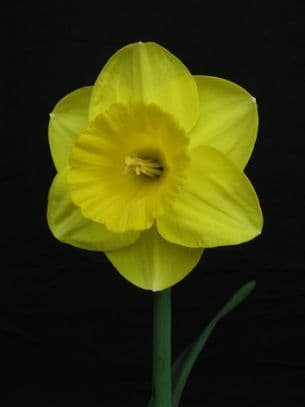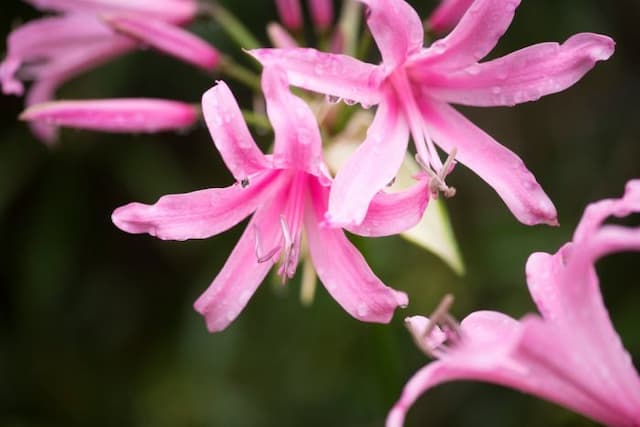Daffodil Narcissus 'Camelot' (2)

ABOUT
Narcissus 'Camelot' is a variety of daffodil recognized for its attractive flowers, which are a cheerful feature of spring gardens. The blooms of this plant are typically large and showy with a striking appearance. The petals, often a vivid yellow, are arranged in a whorl around a central trumpet-like corona, which may be a deeper orange or sometimes a contrasting color, depending on the cultivar. This central corona is frilled at the edge, adding a touch of elegance to each flower. The plant produces sturdy, upright stems that are topped with these individual flowers or occasionally arranged in clusters. Surrounding the bloom, there is a set of narrow, sword-shaped leaves that emerge from the base of the plant. These leaves are green and have a slightly arching habit which forms a tuft around the stem. Notably, daffodils have a fresh, spring-like fragrance that contributes to their allure come blooming season. Narcissus 'Camelot' is a bulbous perennial, which implies that it grows from a bulb buried beneath the soil surface. Each year, these bulbs produce new green foliage and floral stems that contribute to the seasonal display. After flowering, the foliage remains for a period before dying back, at which point the plant enters a dormant phase until the following growing season.
About this plant
 Names
NamesFamily
Amaryllidaceae
Synonyms
Camelot Daffodil, Camelot Narcissus
Common names
Narcissus 'Camelot'
 Toxicity
ToxicityTo humans
Daffodil is the common name for Narcissus 'Camelot'. Daffodils contain toxic alkaloids like lycorine that can be harmful if ingested. Symptoms of daffodil poisoning may include nausea, vomiting, abdominal pain, and diarrhea. In severe cases, ingestion can lead to more serious effects such as cardiac arrhythmias, low blood pressure, tremors, and seizures. Handling the bulbs may also cause skin irritation or an allergic rash in susceptible individuals.
To pets
Daffodil is the common name for Narcissus 'Camelot'. Daffodils are toxic to pets such as dogs and cats. The toxic components, including lycorine, are present in the bulbs, leaves, and flowers. If a pet ingests any part of the plant, symptoms can include vomiting, salvation, diarrhea, abdominal pain, and sometimes more severe symptoms like cardiac arrhythmias and convulsions. In extreme cases, ingestion can be fatal. It is essential to keep pets away from daffodils and seek veterinary care immediately if ingestion is suspected.
 Characteristics
CharacteristicsLife cycle
Perennials
Foliage type
Deciduous
Color of leaves
Green
Flower color
Yellow
Height
1-1.5 feet (30-45 cm)
Spread
0.5 feet (15 cm)
Plant type
Bulb
Hardiness zones
4-9
Native area
Europe
Benefits
 General Benefits
General Benefits- Attracts Pollinators: Narcissus 'Camelot' attracts bees, butterflies, and other beneficial insects, promoting biodiversity in the garden.
- Easy Care: This variety of daffodil is relatively low maintenance, requiring minimal care once established.
- Spring Blooms: It provides early spring color, often one of the first flowers to bloom signaling the end of winter.
- Drought Tolerant: Once established, it can tolerate periods of low water, making it suitable for xeriscaping or drought-prone areas.
- Deer and Rodent Resistant: The bulbs and flowers are typically resistant to deer and rodents, reducing the need for protective measures.
- Multiplies Naturally: The bulbs can naturalize and multiply under the right conditions, providing more flowers over time without additional planting.
- Ornamental Value: With its bright and cheerful blooms, it adds ornamental value to gardens and landscapes.
- Long Blooming Period: Narcissus 'Camelot' usually has a lengthy flowering period which can last several weeks, providing extended visual interest.
- Perennial Growth: Being a perennial, it returns year after year, saving the need to replant annually.
 Medical Properties
Medical Properties- This plant is not used for medical purposes.
 Air-purifying Qualities
Air-purifying QualitiesThis plant is not specifically known for air purifying qualities.
 Other Uses
Other Uses- Daffodil 'Camelot' bulbs can be used as a natural rodent repellent. Planting them around the perimeter of a garden can help deter mice and voles, which do not like the taste of the bulbs.
- The flowers can be used in dye-making. Daffodils can provide varying shades of yellow dye for textiles, often requiring a mordant to fix the color.
- Daffodils, including 'Camelot', are sometimes used in flower therapy or chromotherapy, where their color and visual presence are said to influence emotions and mental states.
- The sap of daffodils can be used as a natural glue in emergency situations, though it can be irritating to the skin.
- Dried daffodil petals can be added to potpourri mixes for their fragrance and to add spring-like colors to the mixture.
- Pressed daffodil flowers can be used in art and craft projects, such as making bookmarks, greeting cards, or decoupage.
- Flower heads of daffodils can be floated in bowls of water as a simple and elegant table decoration for springtime events.
- Daffodil flowers can be used in photography as subjects to teach macro photography techniques because of their intricate structures and vibrant colors.
- Daffodil 'Camelot' stems can be used in weaving small baskets, wreaths, or other handicrafts when dried and treated properly.
- The cut flowers can be a non-toxic way to add a splash of color to drinks or salads. However, only the petals should be used, as other parts of the plant are toxic if ingested.
Interesting Facts
 Feng Shui
Feng ShuiThe Daffodil is not traditionally used in Feng Shui practice.
 Zodiac Sign Compitability
Zodiac Sign CompitabilityThe Daffodil is not used in astrology practice.
 Plant Symbolism
Plant Symbolism- Self-Love: Named after the Greek myth of Narcissus, this flower represents self-love and self-obsession as Narcissus fell in love with his own reflection.
- New Beginnings: Often associated with Chinese New Year and symbolizing the coming of spring, daffodils (the common name for Narcissus) represent rebirth and new beginnings.
- Renewal: As they are one of the first flowers to bloom in spring, daffodils signify the end of winter and the renewal that the new season brings.
- Unrequited Love: In some traditions, the daffodil reflects unreciprocated love, deriving from the story where Narcissus did not reciprocate the feelings of those who loved him.
- Prosperity: In many cultures, daffodils are seen as a symbol of wealth and success. The association with prosperity is particularly strong in the East during festivals such as the Chinese New Year.
- Inspiration: The bright appearance and early spring bloom can symbolize creativity, inspiration, and the ability to overcome challenges.
 Water
WaterDaffodil 'Camelot' should be watered thoroughly whenever the soil feels dry to the touch at about the top inch of soil. During the active growing season, this might mean watering once a week, but this frequency can vary depending on climate and weather conditions. It's essential to avoid overwatering to prevent root rot; thus, ensuring good drainage is crucial. During their dormancy period after flowering, reduce watering significantly. When watering, provide enough water to soak the soil thoroughly, which could be around 1 gallon for an outdoor plant, depending on its size and the soil's dryness.
 Light
LightDaffodil 'Camelot' flourishes in a spot with full sun to partial shade. They do best with at least 6 hours of direct sunlight each day, so an east or south-facing garden or window is ideal, where they can enjoy the morning sunshine. Daffodils are quite adaptable but will thrive and bloom most bountifully with adequate light.
 Temperature
TemperatureDaffodil 'Camelot' prefers a temperate environment, thriving in temperatures ranging from 50°F to 70°F. They are hardy plants that can withstand winter cold and survive temporarily at temperatures as low as 20°F. Daffodils begin growth in late winter to early spring, so the ideal temperature conditions for initiating growth are the cooler temperatures of early spring.
 Pruning
PruningDaffodil 'Camelot' should be deadheaded after flowering by removing faded flowers, which helps to direct the plant's energy to bulb growth instead of seed production. Pruning is minimal; simply cut back the foliage after it has yellowed and died back naturally, usually about six weeks after flowering. Avoid cutting the green foliage prematurely, as this can weaken the bulb for the next year.
 Cleaning
CleaningAs needed
 Soil
SoilDaffodil 'Camelot' thrives in well-draining soil with a pH of 6.0 to 7.0. A good soil mix for daffodils includes loamy garden soil, peat, perlite, and a bit of compost, which provides nutrients and improves drainage. Avoid soils that are too heavy or clayey to prevent waterlogging.
 Repotting
RepottingDaffodils like 'Camelot' typically don't need to be repotted often; they can remain in the same spot for several years. However, if bulbs become overcrowded or soil quality deteriorates, repotting every 3 to 5 years may be necessary.
 Humidity & Misting
Humidity & MistingDaffodil 'Camelot' prefers average humidity levels and does not require high humidity environments. It's adaptable to the typical humidity found outdoors in temperate regions.
 Suitable locations
Suitable locationsIndoor
Place 'Camelot' in bright light indoors; keep soil moderately moist.
Outdoor
Plant 'Camelot' in sunny spot; ensure soil has good drainage.
Hardiness zone
3-9 USDA
 Life cycle
Life cycleNarcissus 'Camelot', commonly known as Daffodil 'Camelot', begins its life cycle as a bulb, planted in the autumn before the first frost. The bulb remains dormant through winter and, with the arrival of spring warmth and moisture, begins to sprout, sending up a shoot and leaves. The shoot grows into a stem that produces a single large flower, typically with a yellow or cream-colored perianth and a darker central trumpet. After blooming in early to mid-spring, the flower wilts and the plant directs energy back to the bulb, where it stores nutrients for the next season. The foliage dies back by late spring or early summer, and the bulb enters another dormant period. This cycle repeats annually, with the bulb potentially producing offsets that may grow into new plants over time.
 Propogation
PropogationPropogation time
Spring-Early Summer
The most popular method of propagation for the Narcissus 'Camelot', commonly known as a type of Daffodil, is through division of its bulbs. The ideal time to propagate by dividing the bulbs is after the foliage has died back in late spring to summer. One should carefully dig around the clump of bulbs and gently lift them out of the soil. The bulbs can then be separated by gently twisting or pulling them apart, ensuring that each division has at least one growing point or bud. These newly separated bulbs can be immediately replanted at a depth of about 6 inches (approximately 15 centimeters) in well-draining soil, spaced 4 to 6 inches (10 to 15 centimeters) apart, to grow and multiply, ready to bloom in the following spring.









